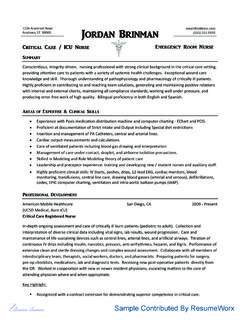Transcription of PERIPHERALLY INSERTED CENTRAL CATHETER …
1 1 PERIPHERALLY INSERTED CENTRAL CATHETER (PICC) Learning Package Return Test to Educator By: Revised June, 2013 2 Table of Content Methods of evaluating competency & Objectives 3 Introduction & Overview of PICC 4 Anatomy & Physiology 6 Indications & Contraindications of PICC 8 Orders & Guideline for Physician notification 9 Nursing Responsibilities 10 PICC Dressings 11 Documentation Overview 13 PICC Flushing Procedural Guideline 16 Needle-less Connector Changes 19 Blood Sampling 21 Complications 23 Appendix A: Discontinuation & Removal 26 Appendix B: Managing Occlusion 28 Appendix C: CVAD Care sets 30 References 31 Tip Culture 33 Post Test 34 3 Competency Evaluation & Objectives Competency Evaluation This learning package is one component of the PERIPHERALLY INSERTED CENTRAL CATHETER (PICC) competency.
2 To meet PICC competency, nurses must: 1. Review the self-learning package on Care and Management of PICCs OR Complete the PICC self-learning module on the Learning Management System 2. Successfully achieve 85% or greater on the PICC test 3. Successfully provide a return demo to a Clinical Nurse Educator on each of the following: --dressing change --flushing --changing a needless connector --blood sampling --removal Additional competencies are required for discontinuation/removal and management of an occluded PICC. ONLY nurses who are deemed competent by the Clinical Nurse Educator may discontinue/remove and manage occlusions 4. Successful demonstration on discontinuation and removal 5. Successful demonstration of occlusion management of PICCs OBJECTIVES The following topics will be covered in this learning package: 1. Basic anatomy for PERIPHERALLY INSERTED CENTRAL CATHETER (PICC) 2.
3 Indications & contraindications for a PICC line insertion 3. Possible complications associated with PICC lines 4. Nursing responsibilities for a) care and maintenance b) dressing & needle-less connector changes c) flushing guidelines d) changing needless connector e) obtaining blood samples Additional competencies are required for discontinuation/removal and management of an occluded PICC. ONLY nurses who are deemed competent by the Clinical Nurse Educator may discontinue/remove and manage occlusions 5. Discontinuation/removal of PICC see Appendix A 6. Occlusion management of PICC see Appendix B 4 INTRODUCTION PERIPHERALLY INSERTED CENTRAL Catheters (PICC) are catheters that are PERIPHERALLY placed ( the arm) but they are considered a CENTRAL CATHETER because the CATHETER tip sits in the CENTRAL circulation ( the superior vena cava).
4 CENTRAL catheters are commonly used to provide a reliable infusion route for infusion therapy of all types, however they can put patients at risk for complications from CATHETER related bloodstream infections which can account for significant health care costs and be life threatening. This learning package will empower clinicians caring for patients with these devices with the tools to prevent complications and promote positive outcomes for patients. PERIPHERALLY INSERTED CENTRAL CATHETER PICC lines can differ in size, make & care and maintenance routines. You might encounter different types of catheters when caring for a patient coming from the community or another institution. Therefore, it is important to know what type of PICC your patient has because care and maintenance practices may vary depending on the type. In general, PICC lines are specially formulated 45-60 cm long catheters and made of polyurethane or silicone.
5 It may be a single, double, or triple lumen. The CATHETER could be valved (does not have a clamp) or non-valved (have an external clamp). Valved catheters such as the Power PICC Solo ( INSERTED at NYGH) help prevent the passive entry of blood into the CATHETER . This provides safety for the patient by preventing blood from flowing backwards when the system is open. PICC line catheters are INSERTED through a peripheral vein (basilic, brachial, or cephalic) so that the tip lies in the distal third of the superior vena cava above the right atrium or at the caval-atrial junction. Pressure Activated Valve Consult with your clinical nurse educator and/or the physician for patients who come from another institution or the community with a PICC line that is not familiar to you. The following diagrams are some examples of PICC lines that you might encounter: 5 Power PICC Solo Non-valved ( clamps) Cook PICC line with Non-Valved Technology, single and double lumen.
6 Groshong Non-Valved PICC line Double Lumen StatLock Securement Device Valved (no clamps ClearClave Needleless Connectors used at NYGH 6 ANATOMY OF THE VEIN WALL The following information is important for understanding the anatomy of the vein and those used for PICC lines: Tunica Adventitia (Outer Layer) Composed of connective tissue Provides support for the vein and allows the vein to roll Blood vessels in this area provide nutrition to this layer Tunica Media (Middle Layer) Largest layer of the vein, composed of elastic and muscle tissue. Innervated by the SNS (fight or flight response) - promotes venous constriction or dilation in response to anxiety, temperature, mechanical or chemical irritation. Pain can trigger vasoconstriction Tunica intima (Innermost Layer) Composed of one layer of smooth and elastic cells. The cells secrete tissue plasminogen activator and heparin to prevent platelet aggregation.)
7 Mechanical injury occurs when the vein wall is injured during insertion or ongoing exposure to the device. Chemical injury occurs when the vein wall is in contact with solutions or medications having hypo-osmolar, hyperosmolar properties, medications with pH< 5 or >9, and/or osmolarity >600 (per INS Standards). Beneath the intima is the subendothelial layer. Damage to this layer causes inflammation and adherence of cells and platelets, which may results in phlebitis, thrombosis, extravasation, and/or infiltration. Valves Allow unidirectional flow of blood back to the heart and prevent pooling in the peripheral circulation. Veins dilate where the valve attaches, this creates a sinus that allows blood to become stagnant and lead to thrombus formation. Valves are present in most veins except in the head, vena cava, very small veins. The longer the vein the more valves it will contain.
8 Difficulty is encountered when threading the vein passed the valves. 7 Veins of the Upper Extremities 1. Basilic Vein: The basilic vein is the first choice for insertion due to number of valves. It originates on the ulnar or medial side of the forearm and ascends on the posterior surface of the arm. Just before reaching the elbow, it travels to the front of the arm until it arrives at the antecubital area where it joins the median cubital vein. The basilic vein joins the brachial vein becoming the axillary vein near the armpit. The number of valves located in the basilica vein is four to six. 2. Brachial Veins: The brachial veins are a pair of veins of the brachial artery in the upper arm. Because they are deep to muscle, they are considered deep veins. They begin where the radial veins and ulnar veins (corresponding to the bifurcation of the brachial artery) and they end at the inferior border of the teres major muscle.
9 At this point, the brachial veins join the basilic vein to form the axillary vein. 3. Cephalic Vein: The cephalic vein originates on the radial or lateral side of the forearm near the thumb. It ascends the lateral side of the arm and is joined by the median cephalic vein just below the antecubital fossa. The cephalic vein is smaller than the basilic vein and may be tortuous as it ascends the upper arm. The accessory cephalic vein joins the cephalic vein at the lateral border of the arm. There is a risk of stricture formation at the junction of the accessory cephalic and the main cephalic vein, which makes this a less desirable point of insertion and passage of a CATHETER difficult. There are a total of six to ten valves. The cephalic vein may also join other veins, such as the external jugular vein. PICC INSERTED into the cephalic vein have a higher incidence of mechanical phlebitis. 3.
10 Medial Cubital Vein This vein drains the palm of the hand and ascends along the anterior surface of the arm to allow communication between the cephalic and basilic veins. It often forms a Y with one branch going to the basilic vein (called the median cubital basilic) and the branch going to the cephalic vein (called the median cubital cephalic). The median cubital vein is often prominent in the antecubital fossa and is frequently used for obtaining blood specimens by venipuncture. Catheters may be INSERTED into this vein and threaded into the main vessel. A venous valve may be encountered where the medial cubital vein joins the main vessel. 4. Axillary Vein The axillary vein is a large vein that forms a direct link to the subclavian vein. The axillary vein lies on the medial side of the axillary artery. Nerves are present between the artery and vein. There is only one valve that needs to transverse before entry into the superior vena cava.








